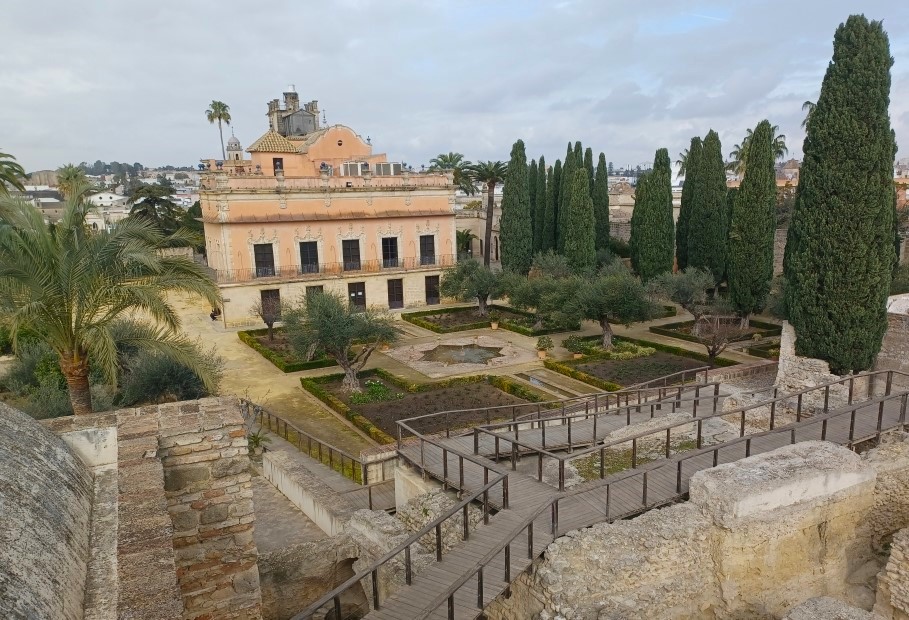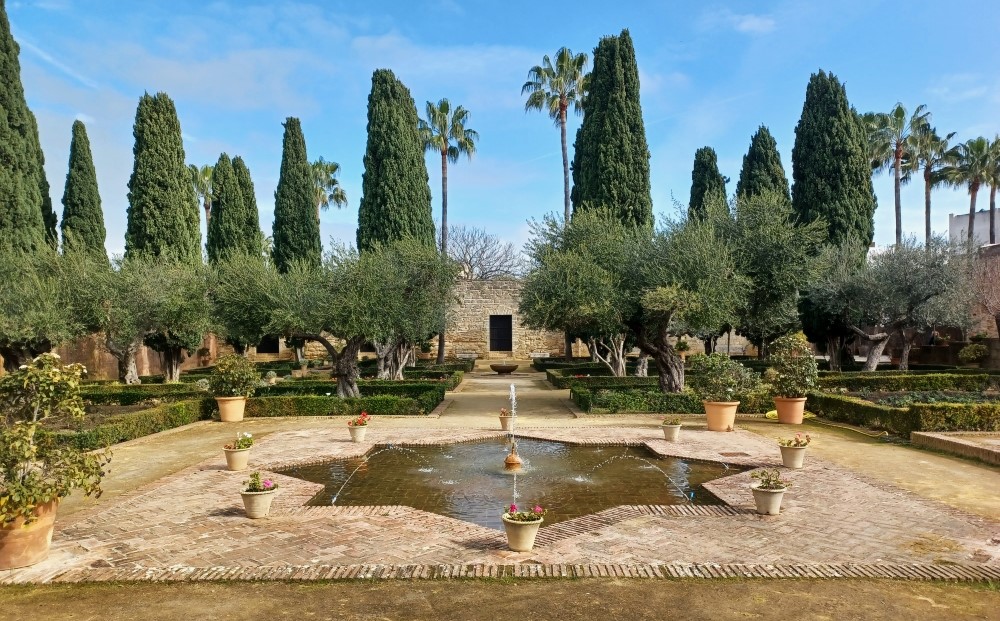The center of sherry culture in Spain, Jerez de la Frontera also is home to unique taverns called Tabancos.
A Short History
Pre-humans arrived in the Iberian peninsula approximately 1.3 million years ago and humans were in the area of current-day Jerez at least since the Neolithic Age (7,000-12,000 years ago).
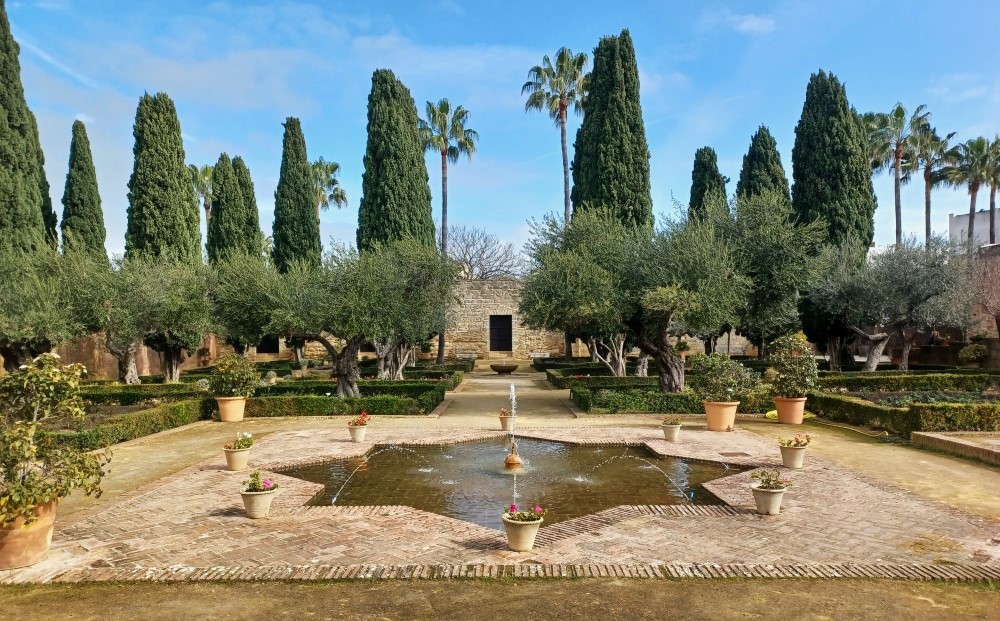
The Phoenicians ruled the region about 3,000 years ago, followed by the Romans. After the fall of Rome, a series of Germanic Tribes ruled until the Umayyad Conquest in the 8th century CE. Muslims ruled the region until 1231 and the Battle of Jerez when Christian forces reconquered the city.
Jerez de la Frontera (Jerez on the Frontier), or, more simply, Jerez, became rich from trade following the Spanish conquest of the New World, bondage of Africans, and theft of riches from Native Americans.
Later, Jerez became a winemaking hotspot known for its production of sherry.
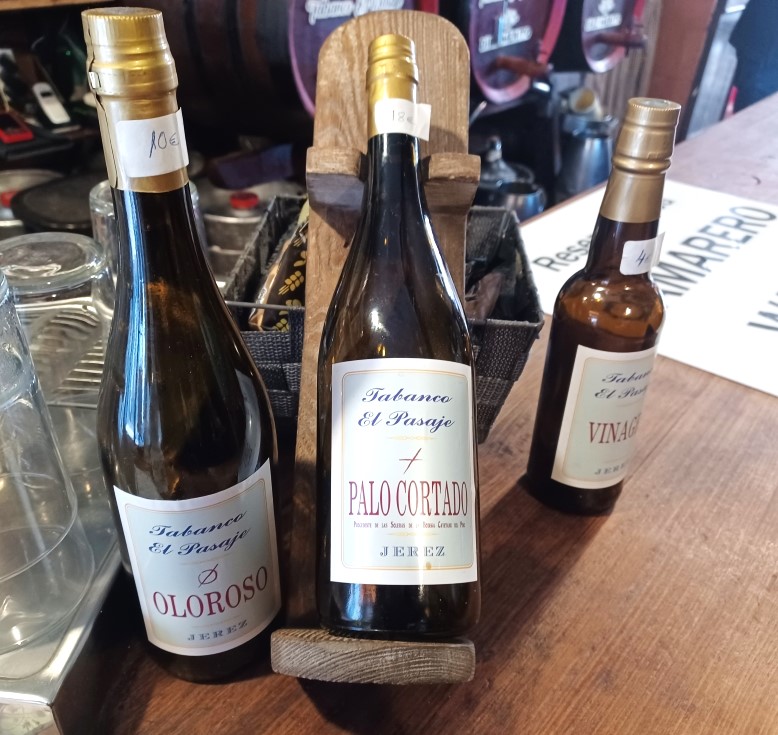
Foodie Jerez
Tapas
Tapas are little plates or snacks often served to accompany a drink. There’s tapas joints all over the world, but the idea originated in Andalucía.
There are competing legends surrounding tapas’ origin, but my favorite is that King Alfonso XIII was passing through nearby Cadiz when he stopped in a tavern for a drink. Cadiz is notoriously windy, so the bartender served the drink with a slice of ham to keep sand from getting in the glass. After that, King Alf, ordered another glass “con la tapa,” or with “with the top,” and tapas was born.
Or, at least that’s the story. In reality, tapa of one sort or another probably existed for decades, if not centuries, before the king wandered into town.
In Jerez, like all of Andalucía, there’s tons of great places to get tapas. Many of them are in the unique bars of Jerez called Tabancos (see below).
One of my favorite spots is Bar Juanito. It’s a traditional spot with pictures of friends and customers from the 70’s all over the walls. And, with a giant picture of an artichoke hanging up, you know you gotta give them a try. Trust me, the artichokes are amazing!

Speaking of artichokes, Tabanco el Pasaje (more below), served their delicious artichoke tapa topped with a sherry deduction. Divine!
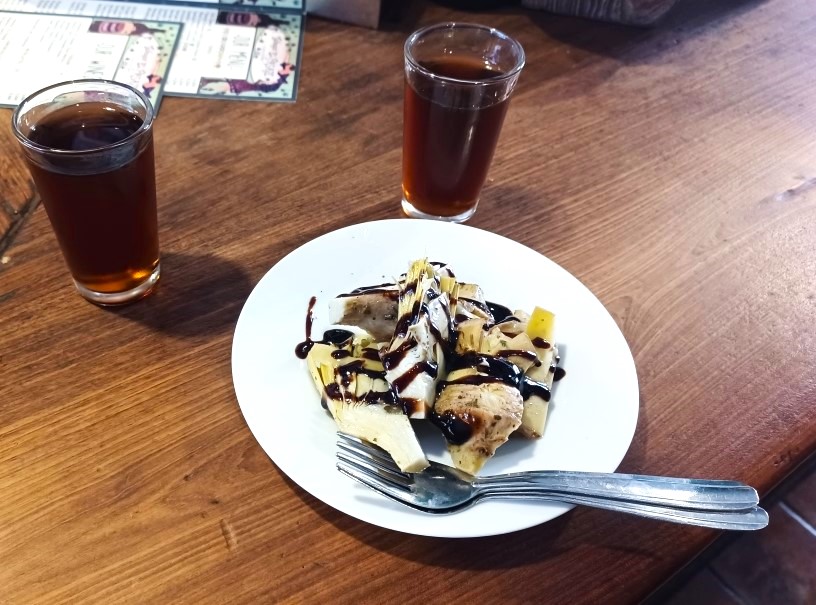
Pastries in Jerez
While the sherry from Jerez is world famous, there’s also some nice local pastries to try.
Tocino de Cielo de Jerez
The best known pastry from Jerez is the Tocino de Cielo de Jerez, or just Tocino de Cielo. Translated is means heavenly bacon, which is a pretty weird name for a dessert. But, there’s a reason.
Tocino de Cielo was invented by the nuns at the Convento de Espíritu Santo de Jerez de la Frontera, a 14th century convent that still stands, though it is no longer in use. Egg whites were used in the convent to clarify wine and as starch for clothing. Because of this, there was a surplus of egg yolks, so many convents came up with so-called Convent Sweets, using the yolks as a base or custard.
For the Tocino de Cielo, a caramel of sugar and water is poured into a pan. Then, a combination of egg yolks, water, and sugar is whisked together and poured on the top. This is baked and then flipped over so that when it is removed from the pan, the yummy custard is now on top.
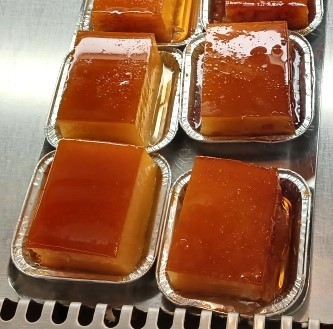
Tocino de Cielo is considered an early version of flan, but differs in that no milk or cream is used (unless it’s topped with whipped cream).
Now, about that bacon name. There are two stories about where this dish got its name. First, the color of the custard is said to resemble bacon, so it became known as Tocino de Cielo.
The other story is that pork lard was originally used in the recipe. While pork fat has been used in some pastries, especially before butter was widely available, this explanation of the name seems unlikely, since no butter is used in the modern recipe.
Still, I wanted to know, so I asked several places that serve Tocino de Cielo in Jerez if they use pork lard in their dish. They all gave an emphatic “No!” Then, I asked if they had ever heard of lard being used in the dish and they all said that they had not. Not scientific, for sure, but I would say it’s pretty definitive.
Several places have Tocino de Cielo on the menu in Jerez. One of my favorite places to get it is Tabanco El Anticuario. Inside is a traditional bar and there’s seating outside when the weather is nice.
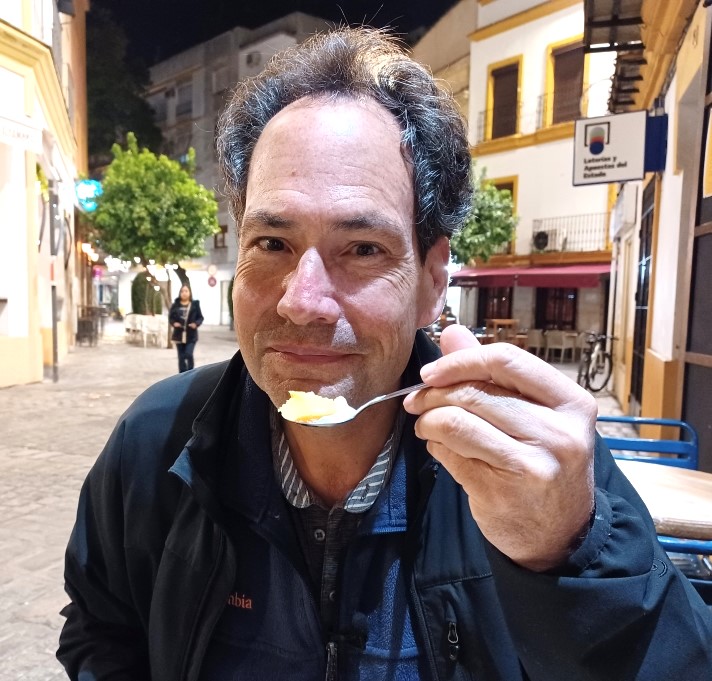
Cocas de Vidrio
Cocas de Vidrio is another pastry with a name that’s difficult for English speakers to unravel. If you put Cocas de Vidrio into Google, the top results are the soft drink Coca Cola.
This makes some sense because when you grab the cookie, you notice how sticky it is, as if it is coated in sugary cola. Then you take a bite and there’s an overwhelming taste of anise, an ingredient in Coke.
However, the real translation of Cocas de Vidrio is “glass cake.” Not very appetizing, but it’s given the name because of the crackling texture. I’ll bet if you drop one on the floor, it would shatter!
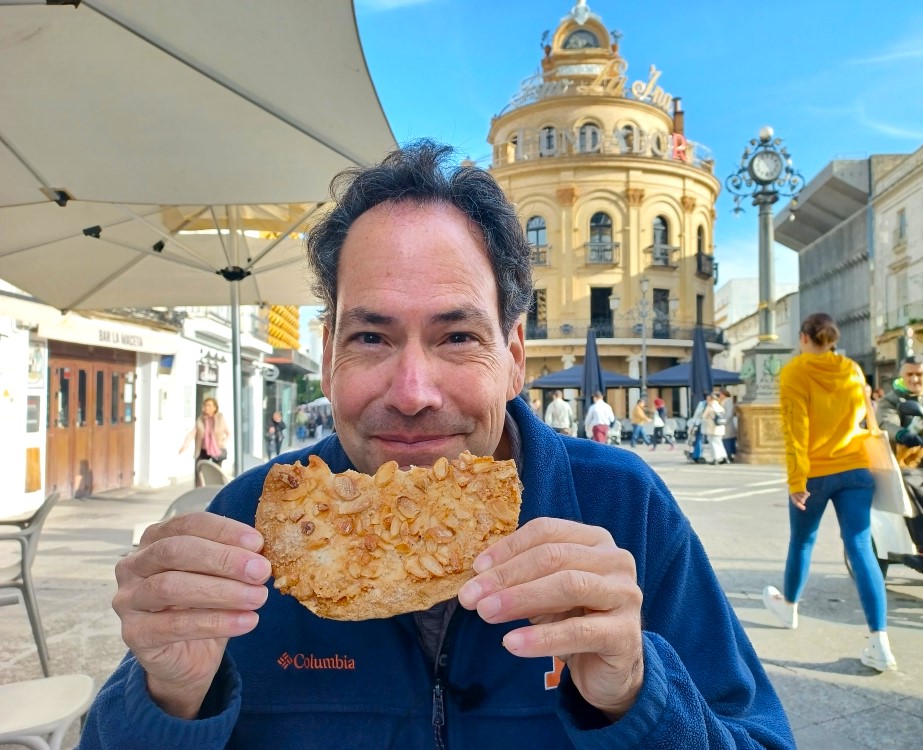
Cocas de Vidrio are originally from Catalonia, the area near Barcelona. But, there’s a great place in Jerez where you can get one.
Granier is a Spanish bakery chain with locations all over Europe. They started in Barcelona, so they know what they’re doing when it comes to Cocas de Vidrio. Super crunchy, sticky, sweet, with lots of anise flavor.
Mercado Central de Abastos
Jerez is home to a great indoor market that’s been on this spot for almost 150 years. “La Plaza” as it’s know by locals, has been renovated several times, with the largest project in the 80’s when the market was in a sad state.
Today, folks shop for their fruit and veggies at “La Plaza” every day. There’s also lots of baked goods, spices, cured olives, dried beans, and flowers. As I say on my podcast, “always visit the local market.” This is especially true in the age of Airbnb, where you might have a kitchen and can do some cooking with local ingredients.
Just outside the market is an unassuming Churro stand called Churrería Manuel. But the long lines betray the quality of the churros. The family has been cranking out some of amazing Churros for over 100 years!
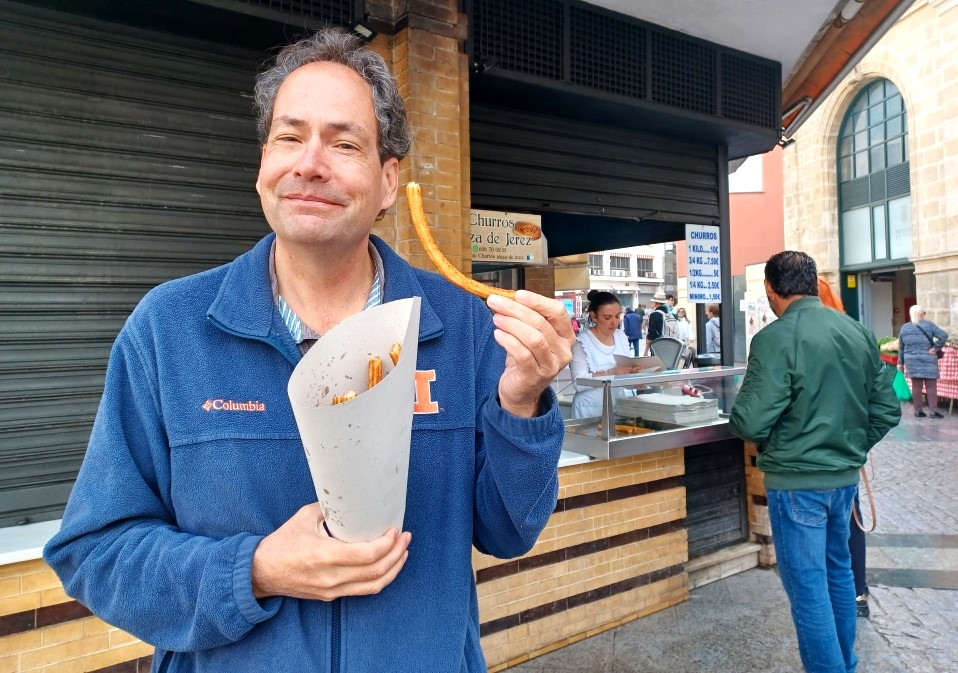
Drinking in Jerez
Sherry
Jerez is part of the Sherry Triangle, where the fortified wine is produced. Wine making in the region goes back over 3,000 years from when the Phoenicians were in the area. Wine making continued with the Roman occupation, but it wasn’t until the 8th century when the Muslims invaded Spain that distillation came to Jerez.
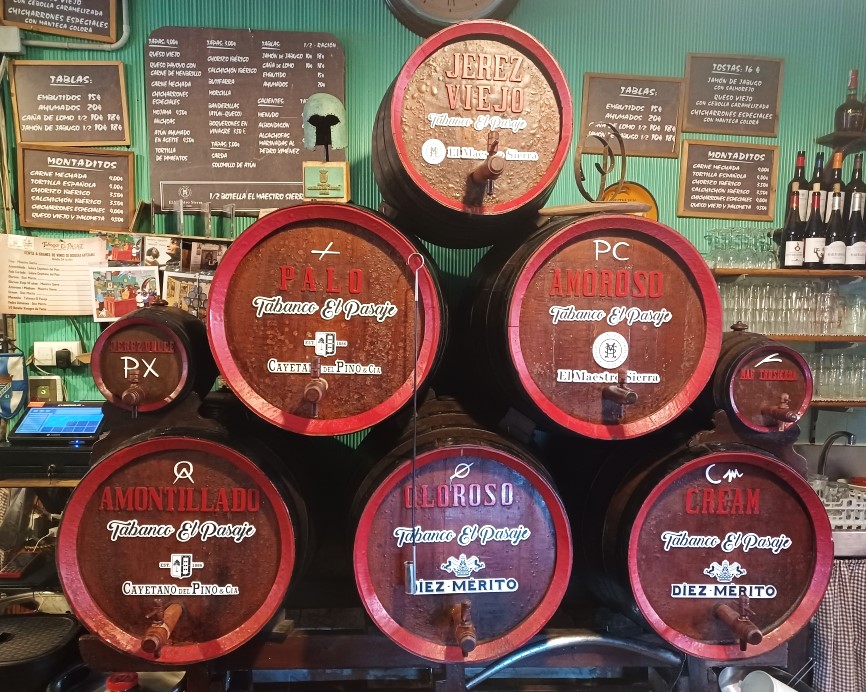
To make dry sherry, Palomino grapes are fermented exactly like a normal dry wine. Once fermentation is complete, a distilled spirit is added to wine the to increase the alcohol content and flavor profile.
There are several kinds of sherry, differing in how they are aged, alcohol content, and sweetness.

Fino is the most popular variety of sherry. It is light, crisp, and dry with very little, if any, sweetness and a golden or straw color. The wine is allowed to age under a layer of yeast, preventing oxidation and giving the sherry it’s distinctive color. Fino is usually 15-17% ABV
Oloroso is more alcoholic (17-22% ABV) than Fino. There is no layer of yeast during barrel aging so the wine oxididizes and turns amber or dark brown in color. Oloroso has a more complex aroma (some say notes of leather and truffle) than Fino.
Palo Cortado (17-22% ABV) is similar to Oloroso in that the yeast layer dies off naturally or is removed early, exposing the wine to oxidation and turning it light brown. Palo Cortado is usually barrel aged 3-4 years.
Amontillado (16-17% ABV) starts fermentation under a yeast layer, like Fino, but later the yeast is removed to allow oxidation. Because it oxidizes for less time, Amontillado is caramel colored, darker than Fino, lighter than Oloroso.
Sweet Sherry
There are a couple varieties of Sweet Sherry as well.
Cream (15-22% ABV) is made when a dry sherry is blended with a naturally sweet wine.
Pedro Ximenez (15-22% ABV), unlike Cream, gets it sweetness by adding a distilled spirit before the sherry is done fermenting. The distillate kills the yeast in the wine, leaving behind some of the natural sugar in the grapes and giving the sherry its sweetness.
Moscatel (15-22% ABV) is made using a similar method to Pedro Ximenez, except that Moscatel grapes are used. This sherry is less sweet than PX.
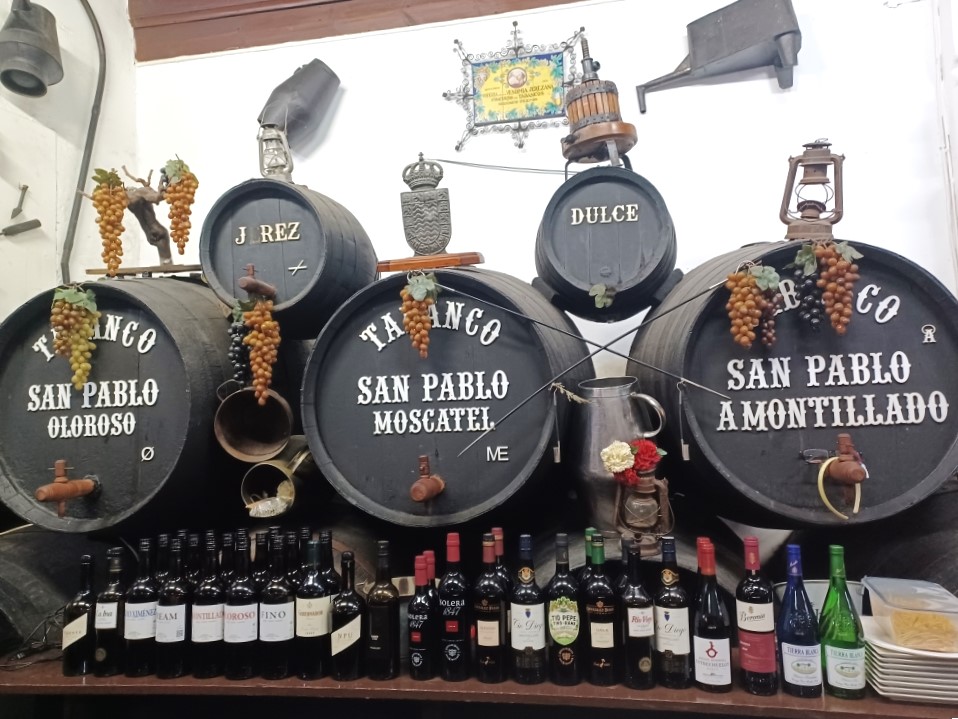
Any Tabanco or bar in Jerez will have sherry available, usually several different varieties. Cafes and bakeries often have a bottle or two as well.
Some of my favorite spots for a sherry in Jerez are El Gallo Azul (cool atmosphere), Tabanco El Pasaje (Flamenco performances), Bar Juanito (traditional bar), and Tabanco La Pandilla (neighborhood Tabanco) though there are literally dozens of great places in the city.
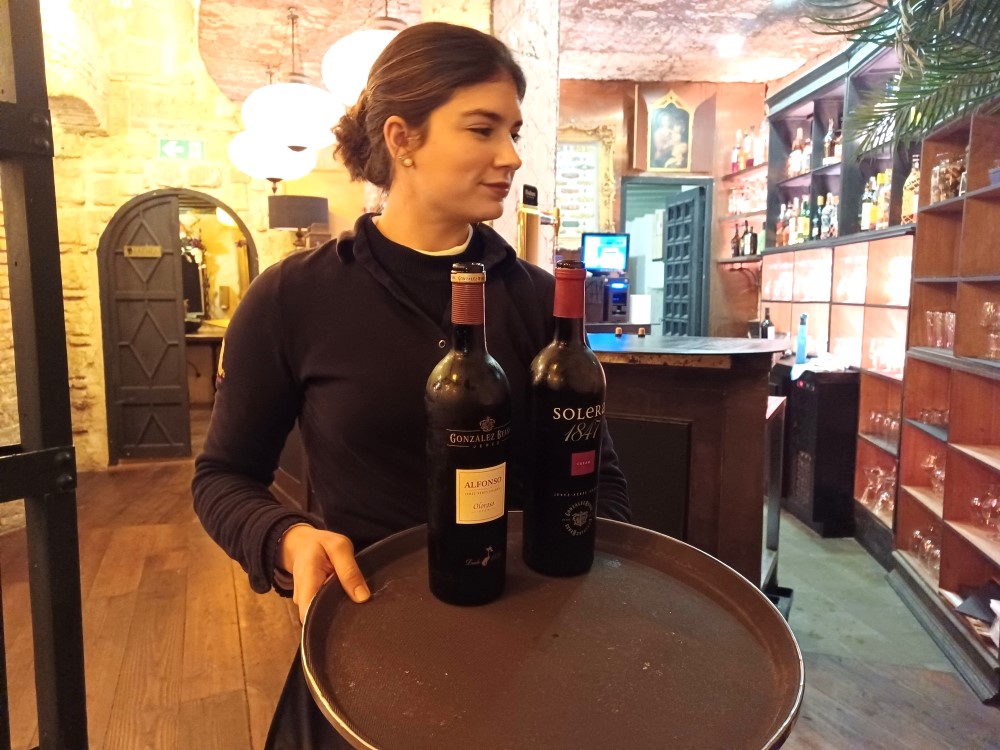
You can also visit a Sherry Bodega in Jerez. Tio Pepe is the most famous one with tours available. They also have a very nice hotel on site. It’s right next to the Alcazar and has incredible views.
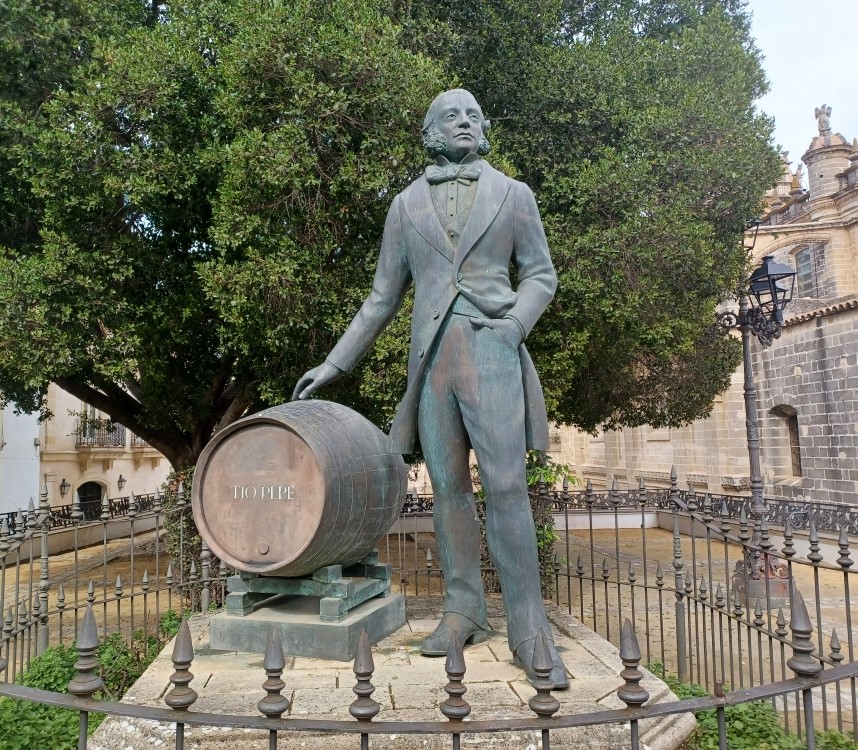
Bodegas Tradicio makes sherry using traditional methods, as indicated by their name. They have a large private collection of artwork by master like Goya and and Velazquez that you can see if you take their tour. For me, I thought the tour was a bit expensive, but if you’re into Goya and sherry, it might be your thing.
Tabancos
Almost everyone has heard of a tapas bar, but unless you’ve been to Jerez, you’ve probably never hears of a Tabanco. A Tabanco is a unique type of bar found almost exclusively in Jerez.
The name Tabanco comes from a fusion of the Spanish words “estanco” (small shops where wine was sold) and “tabaco” (tobacco). Tabancos are like Tapas bars in that they are a place where locals gather to have a drink and a snack.
However, at a Tabanco, you will probably get a glass of sherry rather than a beer or wine. In addition, there are barrels of sherry at a Tabanco, so you can buy it in bulk to take home.
Tabancos also often have Flamenco performances, though not always.
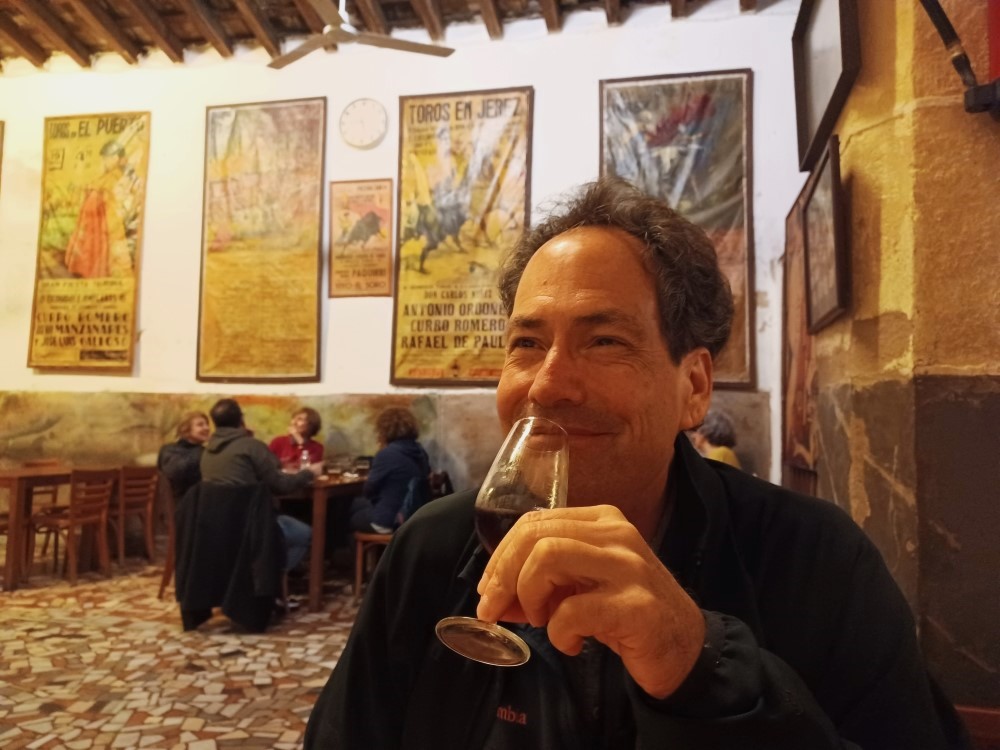
And, like a tapas bar, you can get delicious little plates to go with your drink.
At the end of the 20th century, it was feared that the Tabancos in Jerez might vanish because of changing tastes. However, a concerted effort was made to save these symbols of the heritage of Jerez and today they seem to be thriving. Visit a Tabanco in Jerez, especially after 10pm and you’ll see all kinds of people enjoying a glass of sherry and a little snack.
My favorite Tabanco in Jerez is Tabanco El Pasaje. They have great food (the artichokes with a sherry wine reduction is amazing) and regular Flamenco performances. Pro tip: if you’re going to El Pasaje for a Flamenco performance, you can sit up front for the best views. However, you’ll be expected to order at least 30€ of food and drink per person for the privilege. Better, in my mind, to stand at the bar with the locals and enjoy the show.
Tabanco La Pandilla is another great spot. Order food by marking your preference on the sheet of paper that looks like a Yahtzee scorecard. The kitchen isn’t much more than a toaster oven to warm the egg sandwiches. But this place has atmosphere to burn. I love that the ladies from the neighborhood come out at night for a sherry with their friends.
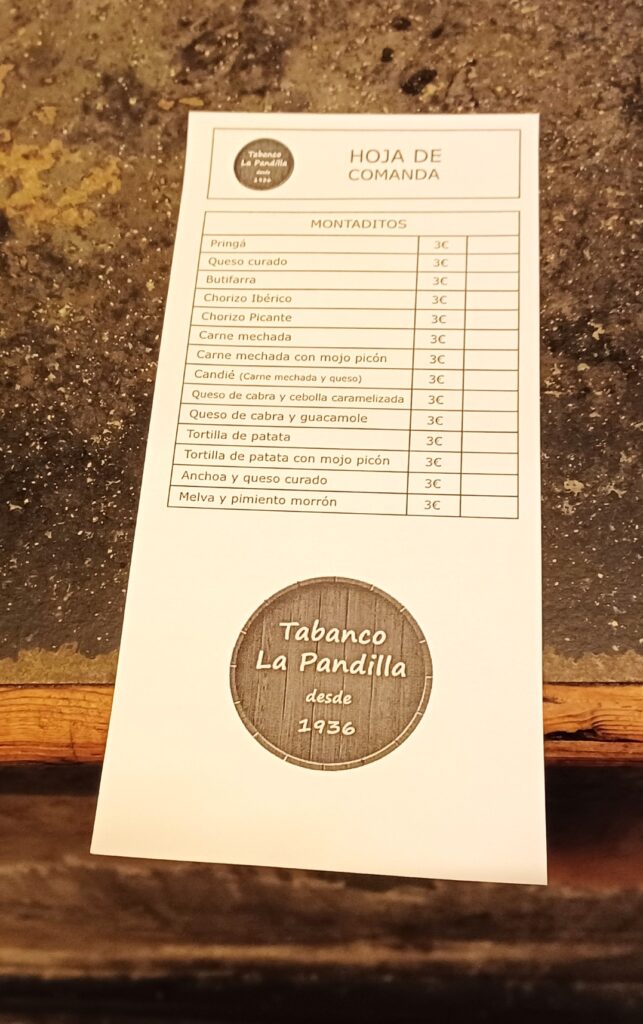
Things to do in Jerez
Flamenco
The annual Jerez Festival takes place from the end of February until the beginning of March. Some of the finest flamenco artists from around the world meet in Jerez to perform during the 2 week celebration.
Jerez is also home to the Andalusian Centre of Flamenco, a cultural center and museum. Flamenco artifacts from the center’s collection are on display and videos of flamenco are regularly shown. In addition, scholars of flamenco and Andalusian culture can study the extensive archives. This is a great spot to go and ask about upcoming flamenco performances in Jerez.
Don Antonio Chacón Cultural Centre, named after the famous singer, is one of the best places to see flamenco in the city, although shows are not regularly scheduled. Peña Flamenca Los Cernícalos also often has shows on Saturdays. For regularly scheduled flamenco gigs, seek out Tabanco el Pasaje. The cramped bar hosts regular Flamenco performances and the tapas is top notch.
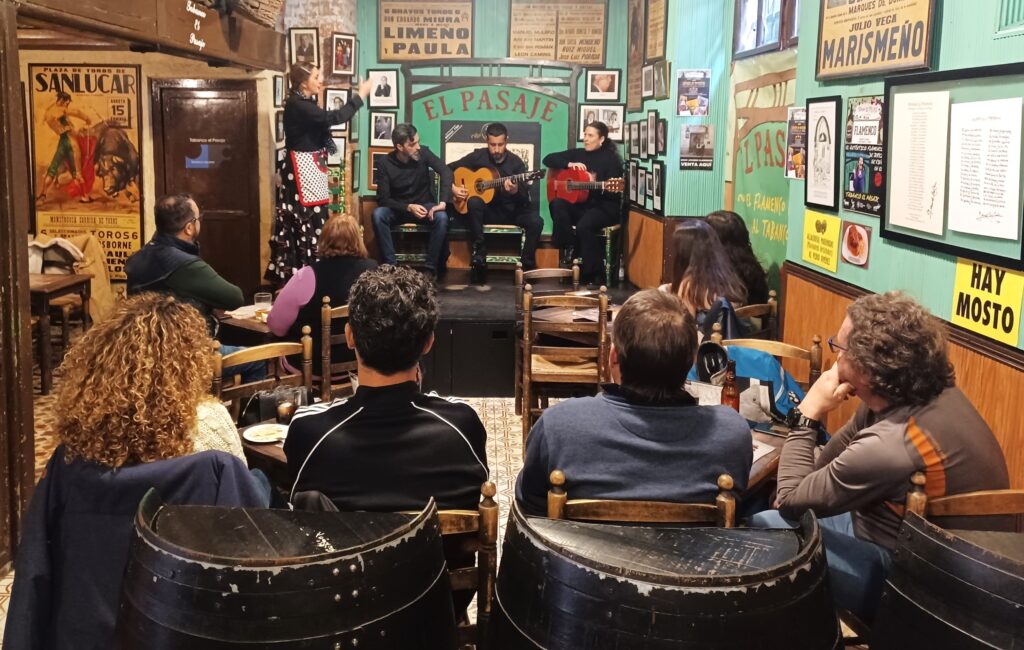
Alcazar of Jerez se la Fontera
In the 8th century CE, the Umayyad Caliphate conquered much of Iberian Peninsula, putting it under Muslim for 500 years. In the 11th century, construction began on the Alcazar in Jerez. This fortress was remodeled and reconstructed over the centuries.
Visiting the Alcazar is a must when in Jerez. The structure was not only a defensive fortress, but also where everyday people lived almost 1,000 years ago.
Inside is the only remaining mosque in Jerez, a city that once had almost 20. There’s also an Islamic bath, Albarrana Towers, a mill, living quarters, and even a giant olive press. Fascinating.
Daytrips from Jerez
Cadiz
Jerez is in the heart of the heart of winemaking region known as the Sherry Triangle. From there, you can make an easy daytrip to Cadiz (35 minutes by train). Cadiz is right on the ocean and has incredible tapas bars and cool sites.
El Puerto de Santa María
El Puerto de Santa María is also part of the Sherry Triangle and is only 10 minutes by train from Jerez. Bodegas serving sherry with flamenco performances dot the city.
Seville
The main city of Andalusia is Seville. The train gets you there in less than an hour if you take the direct one, otherwise, it’s about an hour and 15 minutes. Seville is the fourth largest city in Spain and with so many great tapas bars and sites like the gothic cathedral, alcazar, and Plaza de España, you could easily spend a week in Seville alone.
Cordoba
Cordoba was once one of the most powerful cities in the world. Today, it is known for the spectacular Mosque-Cathedral and the famous Salmorejo soup. It’s about 2 hours by train from Jerez. I’ve written a complete Foodie Travel Guide to Cordoba.
Granada
Granada is a little further afield, 3.5 hour train ride from Jerez, longer if you have to make one or more connections. The trip is worth it to see the spectacular Alhambra.
Madrid
Madrid is the capital of Spain and worth much more than a day. But, you can get to Madrid from Jerez on the high speed train in about 4 hours. I’ve written a complete Foodie Travel Guide to Madrid.
Transportation
There is a small airport in Jerez with a few flights to other cities in Spain and greater Europe. Buses depart for Jerez from outside the terminal while train service (15 minutes to downtown) are across the car park.
More likely, you will be arriving to Jerez by bus or train. The train from Seville is a little quicker (about 65 minutes compared to 75 for the bus) but both are good options.
The historic center of Jerez is compact and very walkable. There is local bus service and taxis are available, though not plentiful. Uber operates in Jerez, but there aren’t a lot of drivers, you can expect to wait for a ride, if you can find one at all.
Index of Things to do in Jerez
Alcazar of Jerez se la Fontera
Thousand year old fortress from the Muslim period.
Calle Alameda Vieja, s/n, 11403 Jerez de la Frontera, Cádiz, Spain
Cathedral of Jerez de la Frontera (Colegiata de Nuestro Señor San Salvador)
17th century Gothic (and Baroque and Neoclassical) cathedral.
Pl. Encarnación, s/n, 11403 Jerez de la Frontera, Cádiz, Spain
Iglesia de San Miguel
Largest church in Jerez with an impressive façade.
Pl. San Miguel, s/n, 11403 Jerez de la Frontera, Cádiz, Spain
Tio Pepe
The most famous sherry producer has tours available in English and Spanish.
C. Puerto, 19, 11401 Jerez de la Frontera, Cádiz, Spain
Bodegas Osborne
Sherry winery in Puerto de Santa Maria with tours available.
C. los Moros, 7, 11500 El Puerto de Sta María, Cádiz, Spain
Bodegas Tradicion
Traditional sherry producer. Expensive tours feature tasting and visit to the large private art collection with works by Goya and Velazquez.
C. Cordobeses, 3, 11408 Jerez de la Frontera, Cádiz, Spain
Centro Cultural Flamenco Don Antonio Chacón
Cultural center named in honor of the famous flamenco singer Don Antonio Chacón.
C. Salas, 2, 11403 Jerez de la Frontera, Cádiz, Spain
Andalusian Center of Flamenco
Library and museum of flamenco.
Centro Andaluz De Flamenco Junta De Andalucía
Peña Flamenca Los Cernícalos
Club where they take Flamenco seriously.
C. Sancho Vizcaíno, 25, 11401 Jerez de la Frontera, Cádiz, Spain
Convento de Espíritu Santo de Jerez de la Frontera
14th century convent where Tocino de Cielo was invented.
C. Espíritu Santo, 9, 11403 Jerez de la Frontera, Cádiz, Spain
Index of Eating & Drinking in Jerez
Tabanco El Pasaje
Excellent Tabanco with regular Flamenco performances.
C. Sta. María, 8, 11402 Jerez de la Frontera, Cádiz, Spain
Tabanco La Pandilla
Very traditional Tabanco with some veg. options.
C. Valientes, 14, 11402 Jerez de la Frontera, Cádiz, Spain
Tabanco El Anticuario
Cool Tabanco with Tocino de Cielo on the menu
C. Tornería, 3, 11403 Jerez de la Frontera, Cádiz, Spain
Tabanco a la Feria
Tabanco with regular Flamenco performances.
junto Plaza Arenal, C. Armas, 5, 11403 Jerez de la Frontera, Cádiz, Spain
Rigodón
Eclectic menu with great vegan options.
C. Basantes, 2, 11403 Jerez de la Frontera, Cádiz, Spain
Bar Juanito
Trad tapas bar, artichokes are their specialty.
C. Pescadería Vieja, 8, 10, 11403 Jerez de la Frontera, Cádiz, Spain
El Gallo Azul
Nice bar with a cool atmosphere, especially upstairs.
C. Larga, 2, 11402 Jerez de la Frontera, Cádiz, Spain
Las Banderillas
Tabanco bar with veg. options.
C. Caballeros, 12, 11403 Jerez de la Frontera, Cádiz, Spain
El Almacen
Tapas joint.
la, C. Latorre, 6, 11403 Jerez de la Frontera, Cádiz, Spain
Alboronia
Restaurant with veg options.
C. Gibraleón, 3, 11403 Jerez de la Frontera, Cádiz, Spain
La Rosa de Oro
The most famous pastry shop in Jerez.
C. Consistorio, 5, y7, 11403 Jerez de la Frontera, Cádiz, Spain
La Dulceria de la Rondeña
Nice candy and pastry shop.
Pl. del Arenal, 11402 Jerez de la Frontera, Cádiz, Spain
Churrería Manuel
Terrific Churros outside the Mercado Central de Abastos.
C. Doña Blanca, 10, 11402 Jerez de la Frontera, Cádiz, Spain
0% Gluten
Spanish chain of gluten free bakeries.
C. Porvera, 5, 11403 Jerez de la Frontera, Cádiz, Spain
Granier
Spanish chain bakery and cafe with Cocas de Vidrio
C. Lancería, 23, 11402 Jerez de la Frontera, Cádiz, Spain
Miel Rancho cortesano
Honey farm on the outskirts of Jerez also has a good vegetarian restaurant.
Desviación el Torno, CA-3111, Km 2, 11593 Jerez de la Frontera, Cádiz, Spain
Shopping in Jerez
Mercado Central de Abastos
Large indoor market.
C. Doña Blanca, 8, 11402 Jerez de la Frontera, Cádiz, Spain
Places to Stay in Jerez
Eurostar Asta Regia
Nice hotel, reasonably priced.
C/ S. Agustín, 9, 11403 Jerez de la Frontera, Cádiz, Spain
Tio Pepe Hotel
Hotel inside the winery, next to the Alcazar. Amazing views.
Pl. Encarnación, 11403 Jerez de la Frontera, Cádiz, Spain
About the Author

Brent Petersen is the Editor-in-Chief of Destination Eat Drink. He currently resides in Setubal, Portugal. Brent has written the novel “Truffle Hunt” (Eckhartz Press) and the short story collection “That Bird.” He’s also written dozens of foodie travel guides to cities around the world on Destination Eat Drink, including in-depth eating and drinking guides in Spain to Madrid, Cordoba, and Puerto de Santa Maria. Brent’s podcast, also called Destination Eat Drink, is available on all major podcasting platforms.





